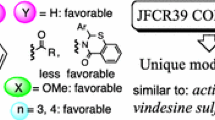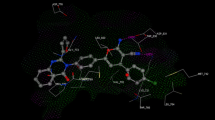Abstract
Ellipticine, olivacine, and their five reduced natural variants were synthesized via a palladium-catalyzed tandem cyclization/cross-coupling reaction as the key step. In addition, a previously unknown conformer of janetine was obtained through conformational inversion of the D ring in janetine. Because there are few synthetic approaches for reduced natural variants, little is known about the biological activities of these compounds. Six synthetic natural alkaloids and five of their derivatives were evaluated for their antiproliferative activity against HCT-116 and HL-60 cells. The activities of variants with the D-reduced ring or without the C(11)-Me group were lower than those of ellipticine. The conformer of guatambuine showed higher activities than guatambuine.




Similar content being viewed by others
Abbreviations
- IC50 :
-
Half maximal inhibitory concentration
- MTT:
-
Thiazolyl blue tetrazolium bromide
- WST-1:
-
Water-soluble tetrazolium salt-1
References
Alvarez M, Joule JA (2001) Ellipticine, uleine, apparicine, and related alkaloids. Alkaloids 57:235–273
Auclair C (1987) Multimodal action of antitumor agents on DNA: ellipticine series. Arch Biochem Biophys 259:1–14
Canals A, Purciolas M, Aymami J, Coll M (2005) The anticancer agent ellipticine unwinds DNA by intercalative binding in an orientation parallel to base pairs. Acta Crystallogr Sect D 61:1009–1012
Charcosset JY, Salles B, Jacquemin-Sablon A (1983) Uptake and cytofluorescence localization of ellipticine derivatives in sensitive and resistant Chinese hamster lung cells. Biochem Pharmacol 32:1037–1044
Dalla Via L, Gia O, Marciani Magno Da Settimo SA, Primofiore G, Da Settimo F, Simorini F, Marini AM (2002) Dialkylaminoalkylindolonaphthyridines as potential antitumor agents: synthesis, cytotoxicity and DNA binding properties. Eur J Med Chem 37:475–486
Deane FM, O’Sullivan EC, Maguire AR, Gilbert J, Sakoff JA, McCluskey A, McCarthy FO (2013) Synthesis and evaluation of novel ellipticines as potential anti-cancer agents. Org Biomol Chem 11:1334–1344
De Simone CA, Malta VRS, Humberto MMS, Porto KRA, Sant’Ana AEG (2006) Crystal structure of 1,2,5-trimethyl-1,2,3,4-tetrahydropyrido[4,3-b]carbazole (guatambuine), C18H20N2, from Aspidosperma subincanum Mart. Z Kristallogr New Cryst Struct 221:233–234. https://doi.org/10.1524/ncrs.2006.0052
Goodwin S, Smith AF, Horning EC (1959) Alkaloids of ochrosia elliptica labill. J Am Chem Soc 81:1903–1908
Gopal M, Shahabuddin MS (2004) Biological properties of 8-methoxypyrimido[4’,5’,4,5]thieno(2,3-b)quinolone-4(3H)-one, a new class of DNA intercalating drugs. Indian J Med Res 119:198–205
Gorczyca W, Gong J, Ardelt B, Traganos F, Darzynkiewicz Z (1993) The cell cycle related defferences in susceptibility of HL-60 cells to apotosis induced by various antitumor agents. Cancer Res 53:3186–3192
Gribble GW, Saulnier MG (1985) Syntheses of ellipticine and related pyridocarbazole alkaloids. Heterocycles 23:1277–1315
Guillonneau C, Nault A, Raimbaud E, Léonce S, Kraus-Berthier L, Pierré A, Goldstein S (2005) Cytotoxic and antitumoral properties in a series of new, ring D modified, olivacine analogs. Bioorg Med Chem 13:175–184
Hewlins MJ, Oliveria-Campos AM, Shannon PV (1984) Synthetic approaches to ellipticine derivatives and analogs of 6H-pyrido[4,3-b]carbazole. Synthesis 289–302
Ishikura M, Hino A, Yaginuma T, Agata I, Katagiri N (2000) A novel entry to pyrido[4,3-b]carbazoles: an efficient synthesis of ellipticine. Tetrahedron 56:193–207
Ishikura M, Takahashi N, Yamada K, Abe T, Yanada R (2008) Formal synthesis of olivacine via indolylborate. Helv Chim Acta 91(10):1828–1837
Ishiyama M, Shiga M, Sasamoto K, Mizoguchi M, He P (1993) A new sulfonated tetrazolium salt that produces a highly water-solble formazan dye. Chem Pharm Bull 41:1118–1122
Itoh T, Abe T, Choshi T, Nishiyama T, Yanada R, Ishikura M (2016) Concise total syntheses of pyrido[4,3-b]carbazole alkaloids using copper-mediated 6-electrocyclization, Eur J Org Chem 2290–2299
Kansal VK, Potier P (1986) Biogenetic, synthetic and biochemical aspects of ellipticine, an antitumor alkaloid. Tetrahedron 42:2389–2408
Khayat D, Borel C, Azab M, Paraisot D, Malaurie E, Bouloux C, Weil M (1992) Phase I study of datelliptium chloride, hydrochloride given by 24-h continuous intravenous infusion. Cancer Chemother Pharmacol 30:226–228
Knölker H-J, Reddy KR (2002) Isolation and synthesis of biologically active carbazole alkaloids. Chem Rev 102:4303–4428
Kohn KW, Waring MJ, Glaubiger D, Friedman CA (1975) Intercalative binding of ellipticine to DNA. Cancer Res 35:71–76
Kraus-Berthier L, Guilbaud N, Léonce S, Parker T, Genissel P, Guillonneau C, Goldstein S, Atassi G, Pierré A (2002) Comparison of the pharmacological profile of an olivacine derivative and a potential prodrug. Cancer Chemother Pharmacol 50:95–103
Miller CM, McCarthy FO (2012) Isolation, biological activity and synthesis of the natural product ellipticine and related pyridocarbazoles. RSC Adv 2:8883–8918
Monnot M, Mauffret O, Simon V, Lescot E, Psaume B, Saucier JM, Charra M, Belehradek J, Fermandjian S (1991) DNA-drug recognition and effects on topoisomeraseII-mediated cytotoxicity. A three-mode binding model for ellipticine derivatives. J Biol Chem 266:1820–1829
Montoia A, Rocha e Silva LFR, Torres ZE, Costa DS, Henrique MC, Lima ES, Vasconcellos MC, Souza RCZ, Costa MRF, Grafov A, Grafova I, Eberlin MN, Tadei WP, Amorim RCN, Pohlit AM (2014) Antiplasmodial activity of synthetic ellipticine derivatives and an isolated analog. Bioorg Med Chem Lett 24:2631–2634
Mosmann T (1983) Rapid colorimetric assay for cellular growth and survival. J Immunol Methods 65:55–63
Ohashi M, Oki T (1996) Ellipticine and related anticancer agents. Exp Opin Ther Patents 6:1285–1294. https://doi.org/10.1517/13543776.6.12.1285
O’Sullivan EC, Miller CM, Dean FM, McCarthy FO (2013) Emerging targets in the bioactivity of ellipticine and derivatives. Stud Nat Prod Chem 39:189–232
Sainsbury M (1977) The synthesis of 6H-pyrido[4,3-b]carbazoles. Synthesis 437–448
Schmutz J, Hunzicker F (1958) Alkaloids of Aspidosperma Olivaceum. Pharm Acta Helv 33:341–347
Shenoy S, Vasania VS, Gopa Ml, Mehta A (2007) 8-Methyl-4-(3-diethylaminopropylamino)pyrimido[4’,5’,4,5]thieno(2,3-b)quinoline (MDPTQ), a quinolone derivate that causes ROS-mediated apotosis in leukemia cell line. Toxicol Appl Pharmacol 222:80–88
Stiborová M, Sejbal J, Bořek-Dohalskґá L, Aimová D, Poljaková J, Forsterová K, Rupertová M, Wiesner J, Hudeček J, Wiessler M, Frei E (2004) The anticancer drug ellipticine forms covalent DNA adducts, mediated by human cytochromes P450, through metabolism to 13-hydroxyellipticine and ellipticine N(2)-oxide. Cancer Res 64:8374–8380
Treat J, Greenspan A, Rahman A, McCabe MS, Byrne PJ (1989) Elliptinium: phase II study in advanced measurable breast cancer. Invest New Drugs 7:231–234
Vassal G, Merlin J-L, Terrier-Lacombe M-J, Grill J, Parker F, Sainte-Rose C, Aubert G, Morizet J, Sévenet N, Poullain M-G, Lucas C, Kalifa C (2003) In vivo antitumor activity of s16020, a topoisomerase II inhibitor, and doxorubicin against human brain tumor xenografts. Cancer Chemother Pharmacol 51:385–394
Acknowledgements
This study was supported in part by a Grant-in Aid for Scientific Research from the Japan Society for the Promotion of Sciences (No. 26460012 for M. I., and No. 17K08369 for N. H.).
Author information
Authors and Affiliations
Corresponding author
Ethics declarations
Conflict of interest
The authors declare that they have no competing interests.
Electronic supplementary material
Rights and permissions
About this article
Cite this article
Itoh, T., Hatae, N., Nishiyama, T. et al. Synthesis and cytotoxicity of pyrido[4,3-b]carbazole alkaloids against HCT-116 and HL-60 cells. Med Chem Res 27, 412–419 (2018). https://doi.org/10.1007/s00044-017-2068-6
Received:
Accepted:
Published:
Issue Date:
DOI: https://doi.org/10.1007/s00044-017-2068-6




